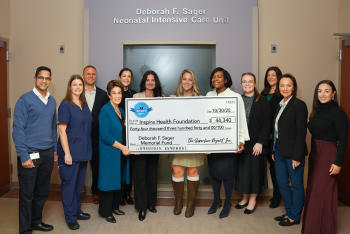Navigate postpartum recovery by addressing mental and physical self-care. Learn key aspects such as...
Read More

Preeclampsia is a pregnancy complication that can be dangerous for both mother and baby. It can be difficult to diagnose, so understanding the signs and symptoms is important for the safety of you and your baby.
Preeclampsia is characterized by an unexpected elevation in blood pressure, also knowns as hypertension, and a buildup of protein in the urine during pregnancy. The condition usually appears around week 20–or the end of the second trimester–but can appear sooner.
“Open communication with your provider is extremely important when it comes to your prenatal health. Although preeclampsia screenings are part of your regular prenatal visits, it’s helpful to understand what symptoms to look out for and discuss any concerns with your obstetrician or midwife,” said Benjamin DiJoseph, D.O., OB/GYN at Inspira Medical Group.
Symptoms may include a decrease in urine, sudden weight gain, abdominal pain, weakness, heart burn, nausea, vomiting, dizziness and swelling throughout the head and face.
If left untreated, preeclampsia can cause a shortage of blood traveling into the placenta and to your baby. This can cause premature birth or low birth weight. In extreme cases, it can also cause a separation of the placenta and the uterus, causing stillbirth.
Babies born prematurely or with low birth weight are at a higher risk of conditions like learning disabilities, vision issues, epilepsy and cerebral palsy. In moms, preeclampsia can cause stroke, heart failure, seizures and water in the lungs.
Preeclampsia is most common in first-time pregnancies, women who become pregnant in their teens, women who become pregnant after 40 or women who are pregnant with multiples. A history of high blood pressure, diabetes, kidney disease, lupus, rheumatoid arthritis or obesity can also signify an elevated risk.
Preeclampsia is also commonly found in multiple family members, which is why it’s important to know your family history.
“The only cure for preeclampsia is delivering the baby, however your treatment plan will vary depending on factors like severity of your condition, health of your baby and how far along you are in your pregnancy,” said Dr. DiJoseph.
In mild cases, your doctor will likely recommend careful monitoring of your heart rate or even blood pressure medications to keep it in check.
“In more severe cases, your doctor may either refer you to a maternal-fetal medicine specialist for close monitoring or schedule your delivery. After 37 weeks of pregnancy, your doctor can safely induce labor or perform a cesarean section to prevent the worsening of preeclampsia,” he said. “However, if your baby is not close to term, your doctor may recommend steroid injections to speed up development and employ more aggressive blood pressure control medicines like hydralazine.”
Following successful delivery, symptoms of preeclampsia usually subside in both mother and baby in one to six weeks.
Pregnancy complications can be stressful and scary, but it’s important to try to remain calm and trust that your care team has the knowledge and experience to keep you and your baby as healthy as possible.
In addition to Maternity services, Inspira offers comprehensive, specialized care for both mother and baby. To learn more, visit:

Navigate postpartum recovery by addressing mental and physical self-care. Learn key aspects such as...
Read More
With equipment purchased through a grant from The Superhero Project Inc. to the Deborah F. Sager...
Read More
Discover Amanda Havey’s inspiring testimonial about her family’s experience at Inspira Vineland NICU...
Read More